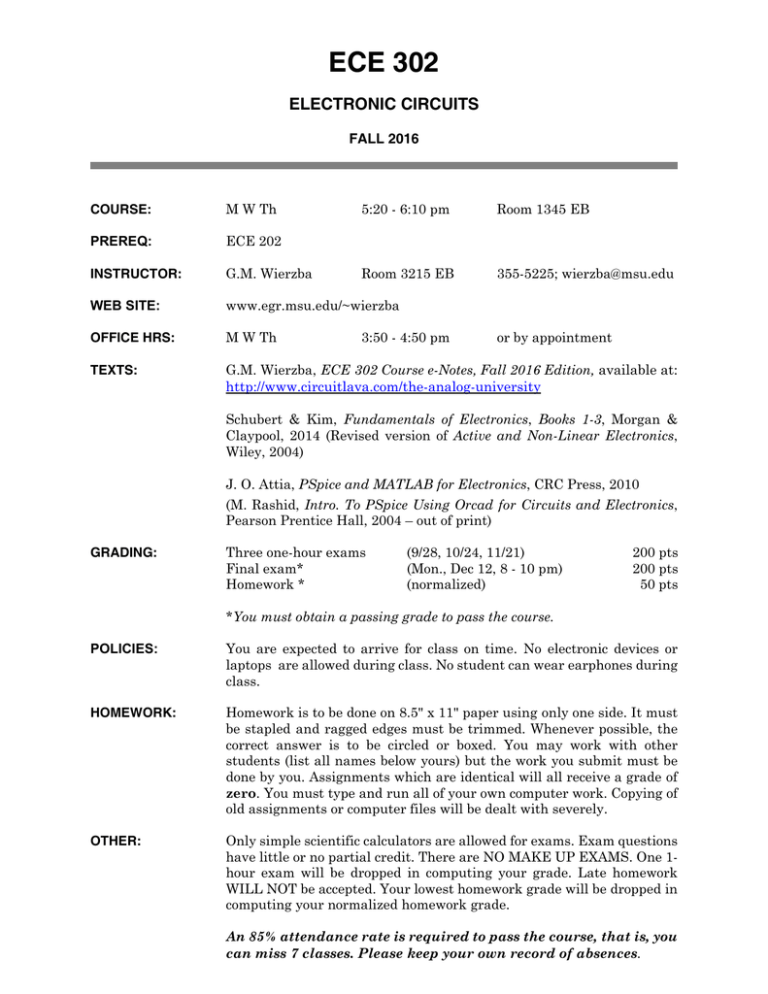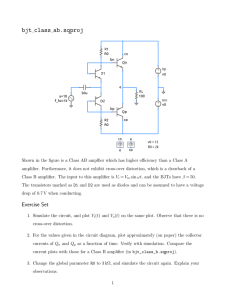
ECE 302
ELECTRONIC CIRCUITS
FALL 2016
COURSE:
M W Th
5:20 - 6:10 pm
Room 1345 EB
PREREQ:
ECE 202
INSTRUCTOR:
G.M. Wierzba
Room 3215 EB
355-5225; wierzba@msu.edu
WEB SITE:
www.egr.msu.edu/~wierzba
OFFICE HRS:
M W Th
TEXTS:
G.M. Wierzba, ECE 302 Course e-Notes, Fall 2016 Edition, available at:
http://www.circuitlava.com/the-analog-university
3:50 - 4:50 pm
or by appointment
Schubert & Kim, Fundamentals of Electronics, Books 1-3, Morgan &
Claypool, 2014 (Revised version of Active and Non-Linear Electronics,
Wiley, 2004)
J. O. Attia, PSpice and MATLAB for Electronics, CRC Press, 2010
(M. Rashid, Intro. To PSpice Using Orcad for Circuits and Electronics,
Pearson Prentice Hall, 2004 – out of print)
GRADING:
Three one-hour exams
Final exam*
Homework *
(9/28, 10/24, 11/21)
(Mon., Dec 12, 8 - 10 pm)
(normalized)
200 pts
200 pts
50 pts
*You must obtain a passing grade to pass the course.
POLICIES:
You are expected to arrive for class on time. No electronic devices or
laptops are allowed during class. No student can wear earphones during
class.
HOMEWORK:
Homework is to be done on 8.5" x 11" paper using only one side. It must
be stapled and ragged edges must be trimmed. Whenever possible, the
correct answer is to be circled or boxed. You may work with other
students (list all names below yours) but the work you submit must be
done by you. Assignments which are identical will all receive a grade of
zero. You must type and run all of your own computer work. Copying of
old assignments or computer files will be dealt with severely.
OTHER:
Only simple scientific calculators are allowed for exams. Exam questions
have little or no partial credit. There are NO MAKE UP EXAMS. One 1hour exam will be dropped in computing your grade. Late homework
WILL NOT be accepted. Your lowest homework grade will be dropped in
computing your normalized homework grade.
An 85% attendance rate is required to pass the course, that is, you
can miss 7 classes. Please keep your own record of absences.
DETAILED TOPICS:
Chapter 2:
2.1
2.2
2.3
2.4
2.5
2.6
2.7
Chapter 3:
3.1
3.4
3.2
3.6
3.5
Diode Characteristics and Circuits
Basic Functional Requirements of an Ideal Diode
Piecewise Linear Model, Transition Point, Assumed States for Analysis,
Strategy for Guessing States
Semiconductor Diode V-I Relationship
Physics of the P-N Junction, Shockley Equation, Approximations, Dynamic
Resistance
Diode as a Circuit Element
Transcendental Equation, SPICE Model Parameters, Software Curve
Tracer, Effects of Temperature
Load Lines
Graphical Solutions to Static Circuits, Inspection Short Cut, Graphical
Solutions of Circuits with Time-Varying Sources
Simplified Piecewise Linear Model
Diode Applications
Positive Clipper with SPICE Evaluation, Negative Clipper with SPICE
Evaluation, Double Clipper with SPICE Evaluation, Half-Wave Rectifier
with SPICE Evaluation, Full-Wave Rectifier with SPICE Evaluation,
Filtered Full-Wave Rectifier with SPICE Evaluation, Transformers, Peak
Detectors, Clamping Circuits, Voltage Multiplier, Or-Gate, And-Gate
Zener Diode and Applications
Piecewise Linear Model, Shunt Regulator, Design - Cigarette Lighter
Adapter for a CD Player, SPICE Evaluation
Bipolar Junction Transistor (BJT) Characteristics
BJT V-I Relationships
NPN BJT, Physical Operation in the Active Region, Physical Operation in
the Cut-Off Region, Physical Operation in the Saturation Region, Physical
Operataion in the Inverse-Active Region, PNP BJT, Ebers-Moll Equations,
SPICE Model Parameters, Software Curve Tracer
Modeling of the BJT in its Regions of Operation
Active, Saturation, Cut-Off, Inverse-Active, Inverse-Saturated, Inverse CutOff, Edge-of-Saturation, Edge-of-Cut-Off, Edge-of-Saturation Reverse, Edgeof-Cut-Off-Reverse
The BJT as a Circuit Element
Assumed States Analysis, Strategies for Guessing the State of an NPN
(PNP) BJT, Load-Line Approach, Ebers-Moll Approach
Biasing the BJT
Fixed Bias Circuit, Emitter Bias Circuit with Two Supplies, Emitter Bias
Circuit with One Supply, Emitter Bias Circuit Design, Biasing PNP
Transistors
Digital Electronic Applications
Resistor-Transistor Logic Gates, Logic Level Diagram, Fanout, Nor-Gate,
Step Response of an RL (RC) Circuit, Switching Inductive Loads, Damping
Diode, SPICE Evaluation, Switching Capacitive Loads, SPICE Evaluation
Chapter 5:
5.2
5.3
5.4
5.5
Chapter 6:
6.1
Chapter 10:
10.X
10.Y
10.6
6.3
Chapter 4:
4.1
4.2
4.3
Single Transistor Amplifiers
BJT Low-Frequency Models
Definition of Small Signal, Small-Signal Analysis Algorithm Small-Signal
Model for an NPN, PNP BJT and a diode
Common-Emitter Amplifier
Voltage Gain, Input Impedance, Current Gain, Power Gain, Output
Impedance, SPICE Verification
Common-Collector (Emitter Follower) Amplifier
Voltage Gain, Input Impedance, Current Gain, Power Gain, Output
Impedance
Common-Base Amplifier
Voltage Gain, Input Impedance, Current Gain, Power Gain, Output
Impedance
Multiple-Transistor Amplifiers
Using Simple Stages Cascaded
Common-Emitter Common-Emitter Amplifier
Frequency Response of Transistor Amplifiers
Departure from Ideal Diode Performance
Depletion Capacitance, Diffusion Capacitance, SPICE Parameters of a
Diode, AC Model of a Diode, SPICE Testing of V-I Characteristics
Departure from Ideal Transistor Performance
SPICE Parameters of a BJT, AC Model of a BJT, SPICE Testing of V-I
Characteristics, Measuring Low Frequency AC Parameters, AC Model for
a BJT (Giacoletto Model)
High-Frequency Amplifiers
Wideband Common-Emitter Amplifier, SPICE Evaluation, Short Circuit
Time Constants, Open Circuit Time Constants, Loading Effects on
Bandwidth
Differential Pairs
Bartlett’s Bisection Theorem, Basic Differential Amplifier, Differential Gain,
Common-Mode Gain, Input Resistance, Common-Mode Rejection Ratio, Current
Source Biasing
Field-Effect Transistor Characteristics
Junction Field-Effect Transistors (JFETs)
N-Channel JFET, Physical Operation in Cut-Off and Ohmic Region,
Physical Operation in Saturation, Character Curves and Equations, PChannel JFET
Metal-Oxide-Semiconductor Field-Effect Transistors (MOSFETs)
Enhancement N-Channel MOSFET, Physical Operation in Cut-Off and
Ohmic Region, Physical Operation in Saturation, Character Curves and
Equations, Enhancement P-Channel MOSFET, FET - BJT Analogy
FET as a Circuit Element
JFET SPICE Model Parameters, Software Curve Tracer, MOSFET SPICE
Model Parameters, Software Curve Tracer, The JFET as a VoltageControlled Resistance with SPICE Verification, The JFET as a Current
4.6
4.3
5.7
5.8
6.1
Chapter 7:
7.1
7.3
7.4
7.6
Source with SPICE Verification
Biasing the FET
Fixed-Bias Circuit, Self-Bias Circuit, Fixed-Plus Self-Bias Circuit
FET as a Circuit Element
NMOS Inverter with a Pull-Up Resistor, NMOS Inverter with Capacitive
Loads, CMOS Inverter, SPICE Transfer Curves, CMOS NOR-Gate, CMOS
NAND-Gate, CMOS Transmission- Gate, Bulk-Pin Potential
FET Low-Frequency Models
Definition of Small Signal, Small-Signal Analysis Algorithm, Small-Signal
Model for an N- and P- Channel JEFT, Small-Signal Model for an N- and PChannel MOSFET
The Common-Source Amplifier
Voltage Gain, Input Impedance, Current Gain, Power Gain, Output
Impedance, Comparison of a Common-Source Amplifier and a CommonEmitter Amplifier
Using Simple Stages Cascaded
Broadband Amplifier: Common-Source Common-Base Amplifier
Power Amplifiers and Output Stages
Power Amplifier Classification
Class A, Total Harmonic Distortion, SPICE Measurement, Efficiency
Complementary Pair Power Booster (Class B Amplifier)
Efficiency, Distortion, SPICE Verification
Class AB Power Amplifiers
15-Watt Power Amplifier
Thermal Considerations

